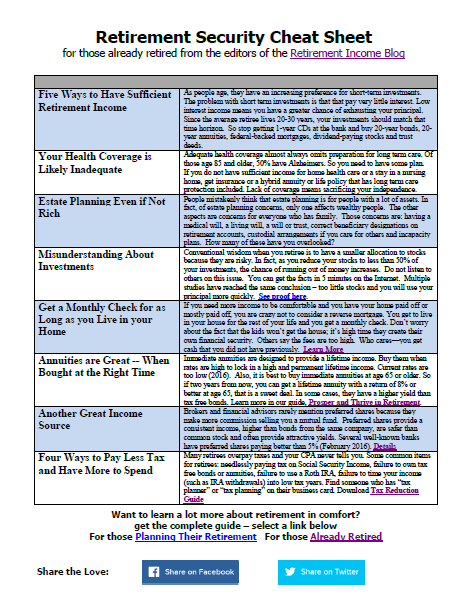If you're nearing retirement, stick to your retirement savings plan. And that includes timely investment allocation to help assure you achieve your goals. Don't let what happened to Joe and Jane happen to you.
Joe and Jane both saved well during their working life. They had created a business together, eliminated all their debt, and managed to build up $750,000 in retirement savings.
They were planning to retire in 6 years. Their retirement savings goal was $1,000,000. They figured at 5% earnings it would give them $50,000 per year - or about $4,170 per month. Along with their Social Security benefits, that $4,170 would make a comfortable retirement for them.
Unfortunately, all their savings were 100% invested in stocks. Investing in stocks had done well for them over their long working years. And they were eager to let things ride. When the market crashed they were left with $450,000 - only 60% of what they had before.
Though Joe and Jane had planned a retirement target date and a retirement savings goal, they lost track of safeguarding their goal with proper allocation of their investments. Indeed, they should've recognized that with only a 5% growth rate per year, their $750,000 would achieve their retirement savings goal in the remaining 6 years to their retirement date.
Allocating your retirement savings means dividing those funds among uncorrelated investments - investments that generally respond differently to the market. Typical allocations are between stocks and bonds. You're looking for appreciation in stock values and interest income with bonds.
Your purpose of allocating is to minimize your retirement savings' vulnerability to market downturns, yet allow you to share in market growth too. The fraction you allocate to different investment types changes as your target date approaches. Shorter investment times means less time to recover if the market turns down. So as you approach your retirement date shift allocation fractions away from stocks toward bonds since the latter are less vulnerable to stock market swings.
With about 6 years to their target date, Joe and Jane should not be 100% invested in stocks. An appropriate allocation might be 60% stock and 40% bonds. In fact they should have some 5% of their retirement savings in cash equivalents too. The table shows how a more time-appropriate allocation of their retirement savings would have better protected from the market crash.
An appropriate allocation won't guarantee you'll suffer no loss in savings if markets head south. But taking a 24% loss under a better allocation beats the 40% loss that Joe and Jane took.
The better allocation would have increased their prospects of recovery. And its 'after crash' allocations (in parentheses) would suggest reallocating again by buying stock at their depressed prices. Doing that could enhance recovery and shorten their 'new' time to retirement.







Leave a Reply